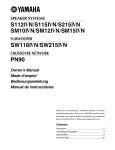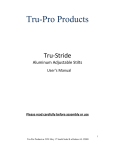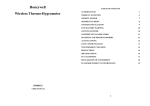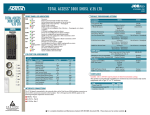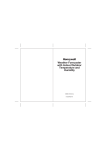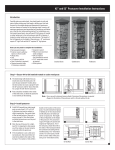Download Yamaha SW118IV Owner`s manual
Transcript
SPEAKER SYSTEMS S112IV/S115IV SM10IV/SM12IV/SM15IV S112IV-OAK S115IVA-OAK SM10IV-OAK/SM15IV-OAK SUBWOOFER SW118IV CROSSOVER NETWORK PN90 Owner’s Manual Mode d’emploi Bedienungsanleitung Manual de instrucciónes Thank you for purchasing a YAMAHA product. To obtain maximum performance from your YAMAHA speaker system and ensure many years of trouble-free operation, we recommend that you read this Owner’s Manual thoroughly before use. Contents Precautions ...................................................................... 2 Connecting the Speakers ................................................ 4 Specifications ................................................................... 6 P.O. Box 1, Hamamatsu, Japan Technical Data ............................................................... 25 Precautions AVOID EXCESSIVE HEAT, HUMIDITY, DUST AND VIBRATION MAKE SURE THE POWER IS OFF BEFORE MAKING OR REMOVING CONNECTIONS When choosing a location for your speakers, avoid the following: Always turn the power switches of system components OFF prior to connecting or disconnecting cables. Failure to do so may result in damage to speakers as well as to con- • Direct sunlight, high temperatures (such as near heaters), or excessively low temperatures. nected equipment. • High humidity. DISCONNECT CABLES BEFORE MOVING THE SYS- • Areas subject to excessive dust accumulation and vibration. TEM To prevent short circuits or breakage of cables, always dis- • Non-level or unstable surfaces. connect cables prior to moving system equipment. HOW TO POWER UP YOUR SOUND SYSTEM MATCH CONNECTOR POLARITY To avoid damage to your speakers and other parts of your system, when you turn on your system, ALWAYS turn the When using two or more speaker systems, be sure match the polarity (+/–) of the speaker system connectors to those power amp on last! This will avoid loud, damaging pops that will annoy your audience, and blow your speakers. When you power down, the amplifier should ALWAYS be at the amplifier. If the polarities do not match, the sounds produced by the speakers will interfere with each other, making it impossible to achieve a well-balanced sound turned off first to avoid the same problems. field. KEEP THIS OWNER’S MANUAL IN A SAFE PLACE FOR FUTURE REFERENCE To protect your speakers When choosing a power amplifier to use with your Poly Switch speakers, make sure that its power output matches the speakers’ power capacity (refer to the Specifications on page 6). Even if the amplifier’s power output is lower All full-range loudspeakers are fitted with a self-resetting poly switch that protects the high-frequency driver from damage caused by excessive power. than the speakers’ PGM (program) power capacity, the speakers may be damaged when clipping of a high input signal occurs. If a loudspeaker cabinet loses high-frequency output, immediately remove power from the unit and wait for two to three minutes. The should allow the poly switch to reset. Re-apply power and check the performance of The following may cause damage to speakers: • Feedback caused when using a microphone. the high-frequency driver before continuing with the power reduced to a level that does not cause the poly switch to interrupt the signal. • Continuous high sound pressure level produced by electronic instruments. • Continuous high-power output distorted signals. On the SW118IV sub woofer, the Poly Switch protects the woofer and a similar routine should be followed if • Popping noises caused by turning on equipment, or by connecting or disconnecting system components while the amplifier is turned on. its output is lost. −2− ATM Fly-Ware This product, when used in combination with amplification and/or additional loudspeakers, may be capable of produc- Model S115IVA-OAK only These speakers are supplied with ATM Fly-Ware rigging ing sound levels that could cause permanent hearing loss. hardware installed. The following notes explain how to prepare these speakers for suspension. DO NOT operate at high volume levels or at a level that is uncomfortable. If you experience any discomfort or ringing in IMPORTANT! This material does not explain how to the ears, or suspect an hearing loss, you should consult an audiologist. To properly suspend any speaker, a knowledge of struc- suspend speakers. tural engineering and structural rigging is REQUIRED. Suspending loudspeakers requires special tools and techniques. Do not attempt to suspend any speaker system un- CAUTION! less you have received specific training to do so. The following five models can be mounted on speaker stands: S112IV, S115IV, SM10IV, SM12IV SM15IV. The The improper installation of flying speakers can result in bodily injury or death. use of Ultimate Support Systems, Inc. Model TS-30 or TS33 speaker stands is recommended. Always consult a licensed engineer to verify the design of any suspended system. In addition, please follow these safety steps: • Use only ONE speaker per stand. • The loudspeakers and stands must always rest upon a • Use only hardware specifically designed for rigging applications. solid, level surface. • Improper installation or usage could result in the loud- • Always use an independent safety suspension system as a backup. speaker falling and causing injury. • The top tube of the TS-30 and TS-33 speaker stands has • Get professional help. a diameter of 1-1/2", but is tapered to 1-3/8" at the top to fit in the mounting holes on the five models named. If you should remove the top tube from a stand, be sure to To prepare these speakers for suspension: insert it with the narrow end up when reassembling. 1. Remove the flathead screws from the top of the speaker. Note: The 3/8" flathead screws use a 7/32" hex wrench. Take care not to remove both screws from each corner, The SW118IV subwoofer has a metal socket to allow mounting of a satellite speaker. Do not use a pole longer than 56". as the internal bracket will fall inside the loudspeaker. 2. Apply a drop of thread locking adhesive to the end of the threads of the eyebolts. SPEAKER HANDLES Note: Please use the supplied eyebolts found in the carrying handle of the speaker. If you use any part other than that supplied, be sure it is Load Rated and know The handles on your speakers are for transportation. They are not designed for suspension or hanging. Only the “A” versions of these speakers are designed for suspension. that it will be de-rated if not suspended so that the pull direction is in-line. Please consult a qualified engineer for proper hanging techniques. 3. Install the eyebolts into the holes on top of the speaker and finger-tighten. 4. Securely tighten the eyebolts. Hand tighten +1/2 turn. 5. Inspect the other six (6) flathead screws, making sure they are tightened down. −3− Connecting the Speakers CONNECTION EXAMPLE 1 The illustration below shows audio connections for a standard setup using two speaker systems. DAISY-CHAINED MIXING CONSOLE L GRAPHIC EQUALIZER L POWER AMPLIFIER L SPEAKER SYSTEMS R R SPEAKER SYSTEMS R DAISY-CHAINING SPEAKERS Since the speaker systems in this series are equipped with two input terminals that are internally connected in parallel, it is possible “daisy-chain” speakers by connecting the output from the power amplifier to one phone jack, and a second speaker system to the other. All speaker models in this series have a nominal impedance of 8Ω. Since most power amplifiers are designed to provide stable performance at a load impedance of 4 or 8Ω, Yamaha recommends that no more than two 8Ω speaker systems be daisy-chained together. This will allow the amplifier to operate properly and avoid overheating. PHONE PLUG WIRING The standard input terminals for this unit are 1/4" phone jacks. Connect the speaker leads as shown in this diagram. Caution: Use only unshielded speaker cable with stranded conductors to connect speakers to the speaker terminals on a power amplifier. The use of audio cable not rated as sufficient for the amplifier’s maximum output level can create a potential fire hazard. −4− CONNECTION EXAMPLE 2 This example shows audio connections for a system using SW118IV Subwoofers and a PN90 Crossover Network. TWO-CHANNEL POWER AMPLIFIER SPEAKER SYSTEM PN90 L L LEFT MIXING CONSOLE L TWO-CHANNEL GRAPHIC EQUALIZER HIGH INPUT SW118IV RIGHT L OUTPUT R R L L LEFT INPUTS TO POWER AMP INPUTS RIGHT R R LEFT LOW INPUT RIGHT OUTPUT R SPEAKER SYSTEM R TWO-CHANNEL POWER AMPLIFIER SW118IV • Do not connect the PN90 between the power amplifiers and the SW118IV subwoofers, as doing so will damage the equipment. • Although the PN90 has a standard load impedance of 15 kΩ, it can be used with loads between 7.5 and 30 kΩ, allowing use with most power amplifiers. • Since the LOW signal polarity is inverted at the crossover point between the LOW and HIGH signals, be sure to reverse the polarity when connecting the SW118IV input jacks to the power amplifier output jacks. This polarity correction must not be made by reversing the polarity of the connections between the PN90 and the power amplifiers, as doing so will damage the equipment. Please reverse the polarity between the power amplifiers and the SW118IVs only. • The PN90 uses unbalanced connectors. Use shielded audio cable with high-quality phone plugs to connect the PN90. The balance between the LOW and HIGH signal levels may be adjusted using the power amplifier volume controls. A good starting point is generally achieved for typical sound sources by raising the LOW signal level about 8 dB higher than that of the HIGH signal. −5− Specifications Model SM10IV /SM10IV-OAK S112IV/SM12IV/S112IV-OAK Enclosure S115IV/SM15IV/S115IVA-OAK/SM15IV-OAK Bass reflex type Speaker Unit LF 10" cone HF 1" driver Frequency Response Power Capacity 12" cone 70 Hz to 20 kHz 60 Hz to 16 kHz NOISE* 100 W 150 W 250 W PGM 200 W 300 W 500 W MAX 400 W 600 W Nominal Impedance 55 Hz to 16 kHz 1000 W 8Ω Sensitivity 95 dB SPL (1W, 1m) Nominal Dispersion 15" cone 2" driver Horizontal 97 dB SPL (1W, 1m) 99 dB SPL (1W, 1m) 60˚ 90˚ Vertical 40˚ Crossover Frequency 1.8 kHz 2 kHz Input Connectors 1.7 kHz 1/4" phone jack x 2 (parallel input) Dimensions (W x H x D) SM10IV: 560 x 339 x 277 mm S112IV: 400 x 638 x 318 mm S115IV: 475 x 712 x 362 mm SM10IV-OAK: SM12IV: 643 x 402 x 344 mm SM15IV: 720 x 485 x 345 mm S112IV-OAK: 400 x 620 x 318 mm S115IV-OAK: 479 x 695 x 360 mm SM10IV: 12.2 kg S112IV: 19.3 kg, SM12IV: 19.5 kg S115IV: 27.5 kg, SM15IV: 26 kg SM10IV-OAK: 10.5 kg S112IV-OAK: 18 kg S115IV-OAK: 27.5 kg, SM15IV-OAK: 26 kg 526 x 316 x 261 mm SM15IV-OAK: 695 x 479 x 340 mm Weight 105˚ 75˚ SM10IV, SM10IV-OAK, S112IV, S112IV-OAK, SM12IV, S115IV, S115IVA-OAK 120˚ H 30˚ SM15IV, SM15IV-OAK H D W D W Model SW118IV Enclosure Model Bass reflex type Speaker Unit Crossover Frequency 18" cone Frequency Response Power Capacity 30 Hz to 2 kHz PN90 90 Hz, 12 dB/octave (at 15 kΩ load) Recommended Load Impedance 15Ω Insertion loss 3 dB NOISE* 250 W Input Connectors 1/4" phone jack x 2 PGM 500 W Output Connectors 1/4" phone jack x 4 MAX 1000 W Dimensions (W x H x D) 227 x 38 x 76 mm Nominal Impedance 8Ω Sensitivity Weight 0.6 kg 96 dB SPL (1W, 1m) Recommended Crossover Frequency 90 Hz, 12 dB/octave Input Connectors φ6.2 1/4" phone jack x 2 (parallel input) Dimensions (W x H x D) 542 x 654 x 791 mm Weight PN90 32.4 kg 63.5 H 216 W SW118IV H Unit: mm *: EIA RS-426 D Specifications subject to change without notice W −6− D Technical Data / Données techniques Technische Daten / Datos técnicos Frequency Response / Impedance Réponse en fréquence/impédance Frequenzgang/Impedanz Respuesta en frecuencia/Impedancia • SM10IV/SM10IV-OAK • S115IV/SM15IV/S115IVA-OAK/SM15IV-OAK 100 100 90 80 16 70 4 20 100 1k 90 80 16 70 60 10k 8 4 20 100 FREQUENCY(Hz) • SW118IV 100 100 90 80 16 70 RESPONSE(dB) 110 RESPONSE(dB) 110 8 4 20 100 10k FREQUENCY(Hz) • S112IV/SM12IV/S112IV-OAK 60 1k 1k 10k 90 80 16 70 60 8 4 20 100 1k FREQUENCY(Hz) FREQUENCY(Hz) −25− 10k Additions 60 8 RESPONSE(dB) 110 RESPONSE(dB) 110 Horizontal Directivity / Directivité horizontale Abstrahlung horizontal / Directividad horizontal • SM10IV/SM10IV-OAK 0° 0° 30 40 0° 0° 40 24 30 10 0 10 0 10 0 0 10 0 10 0 10 21 0° 20 30 40 30 40 30 40 180° 180° 21 0° 20 0° 0° 15 24 50 270° 0° 15 20 12 10 12 0° 0 50 90° 0 50 90° ° 60 10 ° 20 0° 60 30 ° 40 30 30 0° 0° 33 30 50 270° • 4kHz • 8kHz • 16kHz 30 ° 0° 33 • 500Hz • 1kHz • 2kHz • S112IV/SM12IV/S112IV-OAK 0° 0° 20 30 0° 40 50 270° 40 30 20 0° 12 0° 180° 21 0° 0° 15 24 180° 21 0° 20 0° 15 10 0° 0 12 0 50 90° 10 0° 50 90° ° 20 60 24 30 ° 60 40 ° 50 270° 30 30 0° 0° 33 ° 30 • 4kHz • 8kHz • 16kHz 30 0° 33 • 500Hz • 1kHz • 2kHz • S115IV/SM15IV/S115IVA-OAK/SM15IV-OAK 0° 0° 20 0° 30 40 0° 30 20 180° −26− 20 0° 21 0° 180° 21 0° 40 24 0° 15 24 50 270° 0° 15 10 12 0 12 0° 0 50 90° 10 50 90° ° 60 20 ° 30 0° 60 40 ° 50 270° 30 30 0° 0° 33 30 • 4kHz • 8kHz • 16kHz 30 ° 0° 33 • 500Hz • 1kHz • 2kHz Vertical Directivity / Directivité verticale Vertikale Richtcharkteristik / Directividad vertical • SM10IV/SM10IV-OAK 0° 0° 20 30 40 0° 50 270° 40 12 0° 10 0 10 0 10 0 0 10 0 10 0 10 21 0° 20 30 40 30 40 30 40 180° 180° 21 0° 20 0° 0° 15 24 30 0° 15 10 12 0° 0 50 90° 0 50 90° ° 10 60 20 ° 24 30 0° 60 40 ° 50 270° 30 30 0° 0° 33 30 • 4kHz • 8kHz • 16kHz 30 ° 0° 33 • 500Hz • 1kHz • 2kHz • S112IV/SM12IV/S112IV-OAK 0° 0° 40 0° 0° 40 24 30 0° 21 20 180° 180° 21 0° 20 0° 0° 15 24 50 270° Additions 30 0° 15 20 12 10 12 0° 0 50 90° 0 50 90° ° 60 10 0° ° 20 30 60 30 30 ° 40 0° 0° 33 ° 30 50 270° • 4kHz • 8kHz • 16kHz 30 0° 33 • 500Hz • 1kHz • 2kHz • S115IV/SM15IV/S115IVA-OAK/SM15IV-OAK 0° 0° 40 12 0° 40 30 20 20 0° 21 0° 0° 15 24 180° 180° 21 0° 50 270° 0° 15 0° 30 0° 20 −27− 12 10 50 90° 0 0° 50 90° ° 0 60 10 ° 60 20 ° 24 30 30 30 40 0° 33 0° 50 270° • 4kHz • 8kHz • 16kHz ° 30 30 0° 33 • 500Hz • 1kHz • 2kHz










